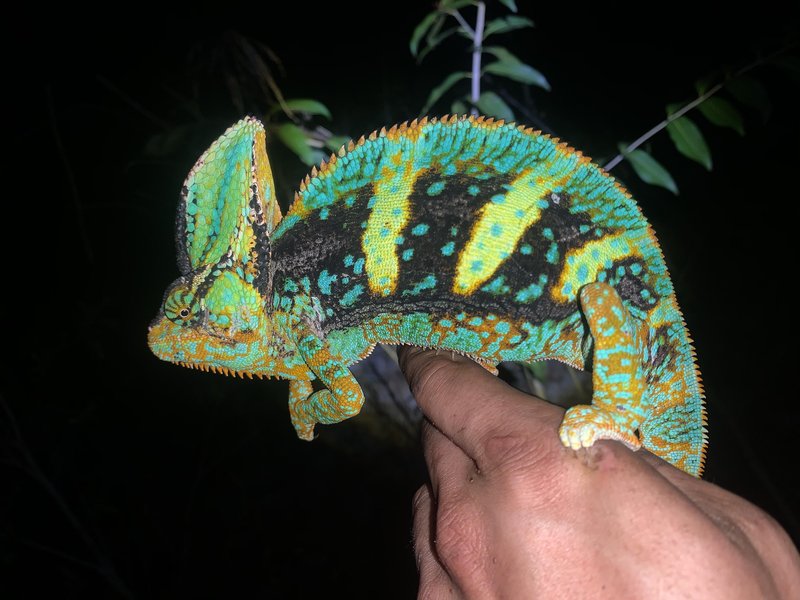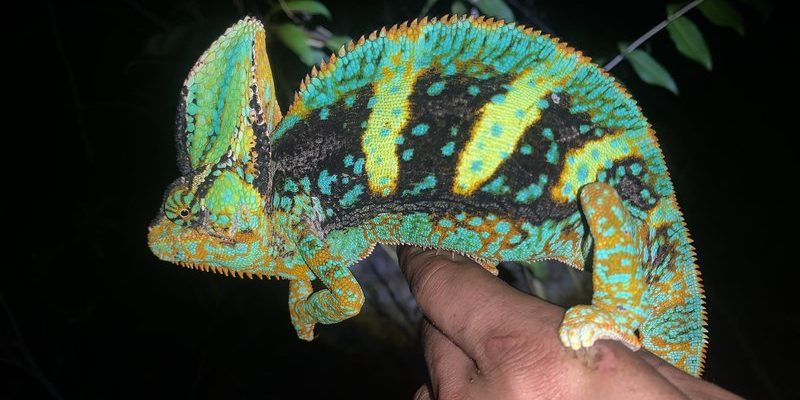
Imagine how tough it must be to live in regions that can swing from scorching heat to cool nights. The veiled chameleon, native to the arid regions of Yemen and Saudi Arabia, has developed some impressive strategies to cope with these challenges. Just like a skilled performer, it uses a mix of strategies to not only survive but also thrive. Ready to discover how this remarkable creature does it?
Unique Adaptations for Temperature Regulation
The veiled chameleon is a pro at handling temperature shifts in its environment. It has unique adaptations that help it regulate its body temperature effectively. Instead of sweating or panting like mammals, these reptiles rely on their behavior and physical features.
First off, their skin reflects sunlight, which helps keep them cool during the blazing heat. You might have noticed that they can change colors; this isn’t just for show! By lightening their skin tone, they can bounce back some of the sun’s rays. It’s like wearing a reflective jacket on a hot day. When it gets cooler in the evenings, they can darken their color to absorb more heat, warming up their bodies like a cozy blanket.
Aside from color changes, you’ll find them using their habitat wisely. They’ll often bask in the sunlight when it’s chilly and find shade when it’s too hot. By moving around their environment, they make sure they’re getting the right balance of warmth and coolness. Talk about clever!
Water Conservation Techniques
Living in arid spaces means water can be scarce. The veiled chameleon has some nifty tricks up its sleeve to avoid dehydration. Instead of drinking from puddles or streams, they have learned to catch droplets of water that condense on leaves in the early morning. Picture a refreshing morning dew; they’re quick to sip whenever they can.
Additionally, these chameleons can also absorb moisture through their skin. This is especially helpful in preventing dehydration during dry spells. It’s similar to how a sponge soaks up water—every little bit counts when you’re in a harsh environment! They’re masters at making the most out of what little they have.
But it doesn’t stop there. The veiled chameleon can also slow its metabolism during particularly dry times. By conserving energy, they can reduce their need for water, ensuring they survive until the next opportunity arises. Isn’t nature just amazing?
Diet and Hunting Skills
The veiled chameleon isn’t just surviving on water; it’s also a formidable hunter. Its diet mainly consists of insects, and they have developed a fascinating method of catching their meals. With their long, sticky tongues, they can catch prey quite effectively. Imagine having a slingshot in your mouth; they can shoot their tongues out with incredible precision to snag insects on the move.
These chameleons are also opportunistic eaters, which means they’ll take advantage of whatever food sources are available. If insects are scarce, they might munch on smaller plants or even fruit. This flexibility in their diet is a key factor in their survival, especially when food sources change due to seasonal variations.
Additionally, they have excellent eyesight. Their eyes can move independently, allowing them to scan their surroundings for both prey and predators. It’s like having a built-in surveillance system that keeps them one step ahead.
Color Change and Communication
You might be wondering why the veiled chameleon can change colors. This ability goes beyond just blending into the environment. Color change serves multiple purposes, especially in communication. When they feel threatened, they can turn darker and more vivid to signal they’re not to be messed with. It’s their way of saying, “Back off, I’m tougher than I look!”
Moreover, color change can also reflect their mood. A happy chameleon might display brighter colors, while a stressed one may appear dull. These hues can communicate with potential mates or rivals, ensuring they establish their territory. This form of communication is vital for social interactions and helps them navigate their relationships in a often harsh social world.
Interestingly, their ability to change colors can also help them regulate their body temperature. The colors affect how much heat they absorb from sunlight, which ties back to their clever survival adaptations. It’s a multi-purpose feature that aids their survival in different ways.
Habitat and Shelter Choices
While the veiled chameleon is adaptable, the right habitat is crucial for its survival. They thrive in arid environments filled with shrubs and trees. These locations offer not just food but also critical shelter from predators and the weather. Think of it as their little oasis in a sometimes harsh desert.
They often choose high perches to bask in sunlight while staying hidden from ground predators. This elevation provides them a strategic advantage—allowing them to observe their surroundings while remaining safe. It’s all about choosing the right place at the right time.
Their homes usually have lots of branches for climbing and hiding, which gives them plenty of options to retreat and protect themselves. When it comes to survival, having the right habitat is half the battle won.
Reproduction and Lifespan Strategies
Even in the wild, the veiled chameleon has a unique approach to reproduction that supports its survival in challenging conditions. The female lays a clutch of eggs in a secure location, often buried in the ground. By doing this, she increases the chances of the eggs hatching successfully. It’s a bit like hiding a treasure—better safe than sorry!
Interestingly, the chameleons have a relatively short lifespan in the wild, typically living up to around 5-7 years. However, a well-cared-for pet chameleon can live much longer. This shorter lifespan means that they must reproduce effectively within their lifetime to ensure the continuation of their species. It highlights the importance of their reproductive strategies in maintaining population levels, especially in tougher environments.
In conclusion, the veiled chameleon is a testament to nature’s ingenuity. From their clever adaptations for temperature regulation and water conservation to their impressive diet and communication skills, they embody the art of survival. As you can see, these remarkable reptiles are not just colorful creatures but also resilient survivors in some of the harshest conditions. Next time you see a chameleon, remember all the determination and skill that goes into thriving in the wild.

